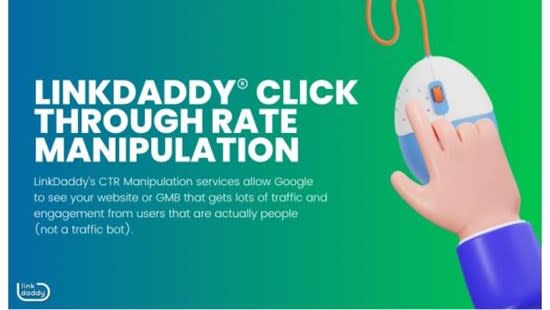Master CTR Manipulation to Skyrocket Your Click-Through Rates
Understanding the nuances of click-through rate (CTR) manipulation is necessary for any kind of electronic advertising and marketing approach aimed at boosting engagement and driving conversions. By utilizing mental triggers such as inquisitiveness and shortage, marketing experts can craft web content that not just captures attention but obliges action. The performance of these strategies pivots on a strong structure of well-structured headings and maximized visuals. As we check out the intricacies of these elements, you could question just how to implement these techniques efficiently and what common pitfalls to stay clear of.
Understanding Click-Through Rate
Click-Through Rate (CTR) is a crucial metric in digital marketing that evaluates the efficiency of online projects. It represents the percentage of users that click a certain web link out of the total number of individuals that view the material, such as an ad or an email. A higher CTR suggests that the web content is reverberating with the audience, while a reduced CTR might suggest a demand for improvement in messaging or targeting.

Recognizing CTR is essential for marketing professionals as it gives insights right into customer interaction and the efficiency of various techniques. A well-optimized CTR can lead to enhanced web traffic, much better conversion prices, and ultimately, greater return on investment (ROI) Therefore, routine surveillance and analysis of CTR should be a basic method for any digital advertising and marketing method, allowing marketing professionals to make data-driven choices and improve campaign performance.

Mental Triggers for Clicks
Efficient digital marketing pivots not only on data analytics but additionally on recognizing the mental triggers that urge customers to engage with material. These triggers are rooted in human emotions and cognitive prejudices, creating pathways for customers to act.
One powerful psychological trigger is inquisitiveness. When customers come across content that ignites their interest or positions an appealing concern, they are more probable to click via to please their interest. In addition, the principle of scarcity can drive necessity; when customers perceive that an offer is restricted, the fear of missing out on out (FOMO) typically moves them to click.
Social proof is one more substantial element, as individuals have a tendency to adhere to the actions of others. Highlighting endorsements or showcasing popular content can develop trust and encourage clicks. The use of vivid imagery and compelling visuals can stimulate feelings, making users much more inclined to engage.
Crafting Engaging Headlines
Headlines serve as the entrance to your material, playing a pivotal function in driving and drawing in clicks engagement. A well-crafted headline not just records interest yet additionally conveys the essence of your content succinctly. It works as a promise to the visitor, suggesting the value they will gain by clicking through.
To create engaging headings, utilize action-oriented language that urges visitors to act. Strong verbs can infuse urgency and enjoyment. Including numbers or listings can boost clarity and supply a tangible takeaway, as in "5 Tips to Enhance Your Click-Through Rate." In addition, positioning a question can pique curiosity, motivating visitors to seek answers within your material (GMB CTR Manipulation).
Avoid clickbait strategies that might lead to disillusionment; instead, make sure that your headlines precisely show the web content they present. By mastering the art of headline crafting, you position your material for optimum presence and involvement, Visit Website ultimately increasing your click-through rates.
Enhancing Visual Components
Aesthetic components are essential to boosting individual involvement and enhancing general material performance. Efficient use of infographics, pictures, and videos can significantly raise the charm of your web content, attracting customers in and increasing click-through rates (CTR) To enhance these visual components, start by ensuring they are high-grade and pertinent, as poor visuals can interfere with your message and reduce individual passion.
Strategically positioning visuals within your content is additionally critical. In addition, take into consideration the usage of thumbnails for video clip material; an appealing thumbnail can attract users to click, driving up CTR.
Analyzing and Testing Techniques
Understanding user behavior via systematic evaluation and testing is crucial for understanding CTR control. To effectively enhance your click-through rates, it is important to employ data-driven techniques that reveal what reverberates with your audience. Begin by examining historic efficiency metrics, determining patterns in user engagement, and segmenting your audience based upon demographics and actions.
Implement A/B screening to contrast different variants of your content, such as headings, images, and calls-to-action. This approach allows you to separate variables and figure out which components generate the greatest engagement. Usage devices like Google Analytics or Heatmaps to collect understandings into customer communications, concentrating on locations that bring in one of the most interest.
Additionally, take into consideration executing multivariate screening to assess several variables at the same time, offering a more extensive understanding of individual preferences. Monitor vital efficiency signs like bounce rates and time on web page to gauge the effectiveness of your approaches.
Conclusion
Understanding CTR adjustment is important for enhancing click-through rates and driving interaction. By understanding the complexities of individual habits and leveraging emotional triggers, web content can go to this website be crafted to resonate properly with the target audience.

When individuals run into material that ignites their rate of interest or poses an intriguing question, they are more most likely to click through to please their curiosity. Effective usage of infographics, images, and video clips can dramatically elevate the allure of your content, attracting individuals in and increasing click-through rates (CTR) In addition, consider the use of thumbnails for video clip content; an engaging thumbnail can lure official source customers to click, driving up CTR.